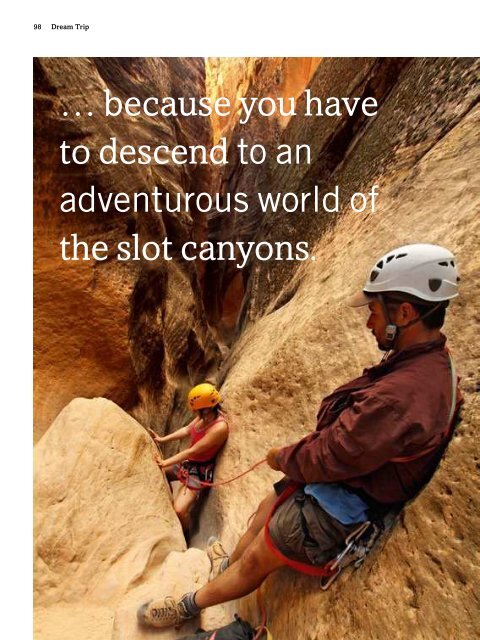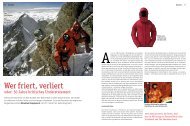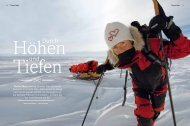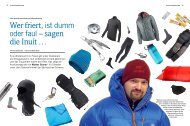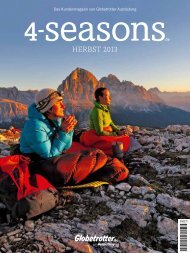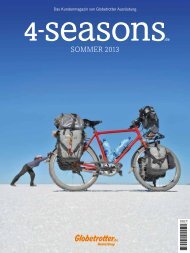autumn 2012 - 4-Seasons.de
autumn 2012 - 4-Seasons.de
autumn 2012 - 4-Seasons.de
Create successful ePaper yourself
Turn your PDF publications into a flip-book with our unique Google optimized e-Paper software.
98 Dream Trip Dream Trip 99<br />
… because you have<br />
to <strong>de</strong>scend to an<br />
adventurous world of<br />
the slot canyons.<br />
Text: Ingo Hübner<br />
Photos: Diana Haas<br />
Do not jump into your automobile and rush out to the Canyon<br />
country. (…) In the first place you can’t see anything from a car;<br />
you’ve got to get out and walk, or better crawl, on hands and knees<br />
(…). When traces of blood begin to mark your trail, you’ll see<br />
something, maybe.<br />
I remain silent, setting free my last precise thoughts that originate<br />
straight from Edward Abbey’s travel journal. Let them rise along<br />
the glowing red rock walls until they disappear into nothingness in<br />
the ultramarine sky. I am a pilgrim, my mind is pure and dwells in<br />
the freshness of the moment. We have just started walking from<br />
the Temple of Sinawava, equipped with a paltry backpack, two<br />
water bottles and a shoul<strong>de</strong>r-high walking stick. I am moving along<br />
the pilgrim stream along the Virgin River straight into Zion Canyon,<br />
the main attraction of Zion National Park. On the way to the<br />
most infamous canyoning tour in America’s southwest: The<br />
Narrows. The sandstone walls are 600 metres high, and no ten<br />
metres apart at their most narrow point. The hike through the canyon<br />
goes for 20 kilometres, most of the people do not walk further<br />
than the first three kilometres. After one hour, there are hardly any<br />
of the other pilgrims left.<br />
Gui<strong>de</strong> Rob has not talked much. I ask him why he has not told us<br />
anything. He says he wanted to let nature tell its own story. I ask<br />
him, who Sinawava was. It is the name of a powerful Paiute Indian<br />
<strong>de</strong>ity that used to live in the area but did not occupy the canyon.<br />
Sinawa means God of tranquillity and kindness and was responsible<br />
for the harvest of the Paiute natives. On the park’s entrance,<br />
the rock Kinasava is sitting there enthroned. This was an evil spirit<br />
that is said to have resi<strong>de</strong>d in the canyon. This is the reason why<br />
Not only stones but also sticks block the way into Slot Canyon.<br />
the Paitute Indians did not settle down near him and only ventured<br />
into the park at daytime. Slowly, Rob starts talking. He is<br />
very earthbound: long blond, messy hair, a tangy summer canyongui<strong>de</strong><br />
odour is in the air. He tells us the story of Zion Canyon’s<br />
great power that attracted many people who moved to Springdale,<br />
the town at the entrance – but had to leave the place after a few<br />
years because they could not handle its power emotionally. Zion<br />
Canyon is supposed to reinforce your karma, too. Rob smiles mischievously.<br />
We wa<strong>de</strong> through water, an invisible stream is pulling<br />
us, we climb across rocks. I get a strong physical feeling for such<br />
sublime nature in its monumental solitu<strong>de</strong>. Until we reach Wall<br />
Street, a weird name for such a quiet place. I marvel with a stiff<br />
neck, feeling tiny, nearly crushed by dignity turned into stone. So<br />
here it is, the power of the rock, of the canyon that Rob was talking<br />
about.<br />
Getting lost in a place<br />
Utah’s southwest boasts a magnificent landscape. It attracted<br />
many people of different kinds with its magnetic character. Mormons<br />
were looking for freedom, artists searched for inspiration<br />
and solitu<strong>de</strong>. Thomas Moran painted it, Everett Ruess turned it<br />
into poetry. It was them who glorified the landscape, raised it to<br />
divinity and turned the rough and remote <strong>de</strong>sert into a place of<br />
dreams and their <strong>de</strong>sire. It is a place they and many others got lost<br />
in. Everett Ruess is probably the most famous artist of the gettinglost-type.<br />
At the same time, he is most clou<strong>de</strong>d in secrecy. He got<br />
it right with just one marketing trick: »I’ve become a little too >


